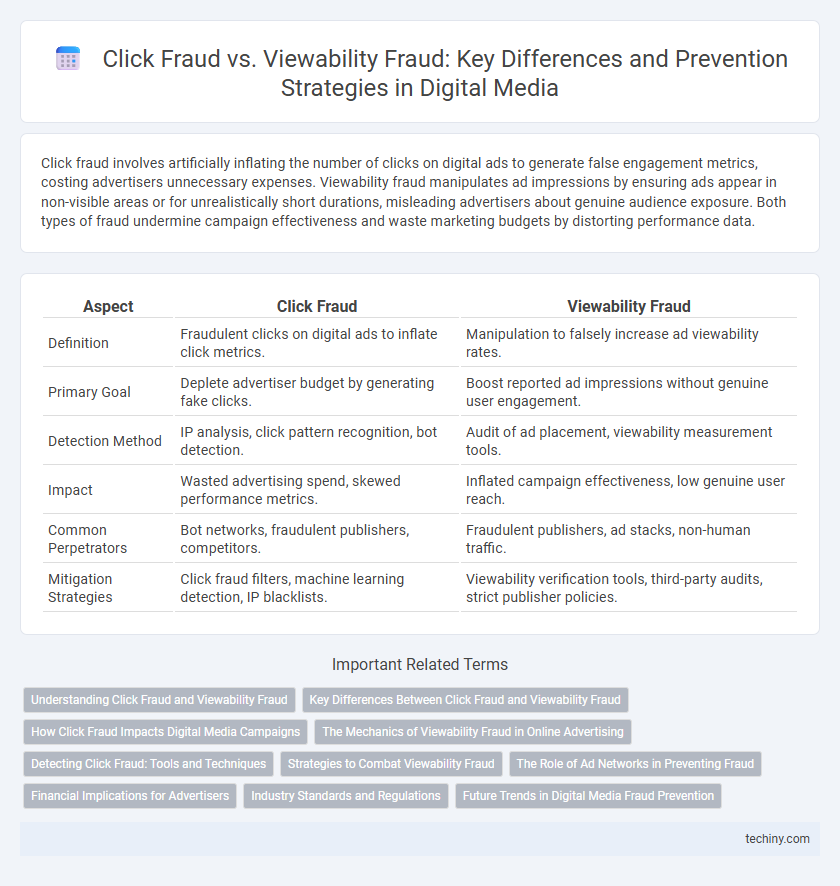Click fraud involves artificially inflating the number of clicks on digital ads to generate false engagement metrics, costing advertisers unnecessary expenses. Viewability fraud manipulates ad impressions by ensuring ads appear in non-visible areas or for unrealistically short durations, misleading advertisers about genuine audience exposure. Both types of fraud undermine campaign effectiveness and waste marketing budgets by distorting performance data.
Table of Comparison
| Aspect | Click Fraud | Viewability Fraud |
|---|---|---|
| Definition | Fraudulent clicks on digital ads to inflate click metrics. | Manipulation to falsely increase ad viewability rates. |
| Primary Goal | Deplete advertiser budget by generating fake clicks. | Boost reported ad impressions without genuine user engagement. |
| Detection Method | IP analysis, click pattern recognition, bot detection. | Audit of ad placement, viewability measurement tools. |
| Impact | Wasted advertising spend, skewed performance metrics. | Inflated campaign effectiveness, low genuine user reach. |
| Common Perpetrators | Bot networks, fraudulent publishers, competitors. | Fraudulent publishers, ad stacks, non-human traffic. |
| Mitigation Strategies | Click fraud filters, machine learning detection, IP blacklists. | Viewability verification tools, third-party audits, strict publisher policies. |
Understanding Click Fraud and Viewability Fraud
Click fraud involves the intentional manipulation of pay-per-click (PPC) advertising by generating fake clicks to inflate advertising costs or deplete competitors' budgets. Viewability fraud occurs when ads are counted as viewed without actually being fully visible or engaged with by real users, often through hidden placements or automated bots. Detecting these fraud types requires advanced analytics and real-time monitoring to protect digital ad campaigns and optimize return on investment (ROI).
Key Differences Between Click Fraud and Viewability Fraud
Click fraud involves the generation of illegitimate clicks on digital ads to inflate click metrics and deplete advertiser budgets, whereas viewability fraud manipulates ad impressions by ensuring ads are counted as viewed without genuine user engagement. The key difference lies in click fraud targeting the interaction metric that drives cost-per-click campaigns, while viewability fraud distorts impression metrics critical for brand awareness and cost-per-mille pricing models. Understanding these distinct fraudulent activities helps digital marketers optimize campaign performance and accurately allocate advertising spend.
How Click Fraud Impacts Digital Media Campaigns
Click fraud drains advertising budgets by generating illegitimate clicks that do not convert into genuine user engagement, leading to skewed campaign metrics and reduced ROI. It disrupts the accurate measurement of campaign performance, making it difficult for marketers to optimize targeting and allocate resources efficiently. As a result, digital media campaigns suffer from data distortion, causing wasted spend and undermining trust in advertising platforms.
The Mechanics of Viewability Fraud in Online Advertising
Viewability fraud in online advertising exploits the metrics used to measure ad visibility by artificially inflating impression counts without genuine user engagement, often through techniques like pixel stuffing or hiding ads behind visible content. Unlike click fraud, which targets pay-per-click campaigns by generating fraudulent clicks, viewability fraud manipulates impression-based models, deceiving advertisers into paying for ads that are never truly seen. Advanced detection methods rely on analyzing user interaction patterns and employing sophisticated algorithms to distinguish authentic views from fraudulent ones, safeguarding digital media investments.
Detecting Click Fraud: Tools and Techniques
Detecting click fraud relies on advanced tools such as machine learning algorithms and IP filtering to identify suspicious patterns and prevent invalid clicks. Techniques like real-time traffic analysis and behavioral biometrics help distinguish genuine user interactions from fraudulent activities. Leveraging data from sources such as click timestamps, device fingerprints, and geographic location enhances the accuracy of fraud detection systems in digital advertising campaigns.
Strategies to Combat Viewability Fraud
Implementing advanced verification technologies such as viewability measurement tools and real-time monitoring systems enhances detection of viewability fraud in digital media campaigns. Leveraging machine learning algorithms to analyze traffic patterns and user behavior helps identify non-human or low-quality impressions that inflate viewability metrics. Collaborating with trusted third-party auditors ensures transparency and enforces strict compliance with industry viewability standards, improving overall campaign effectiveness.
The Role of Ad Networks in Preventing Fraud
Ad networks play a crucial role in combating click fraud and viewability fraud by employing advanced detection algorithms and real-time monitoring systems to analyze traffic patterns and verify genuine user interactions. These networks leverage machine learning models to identify anomalies such as automated clicks or non-human views, ensuring that advertisers pay only for legitimate engagement. By collaborating with third-party verification services and maintaining strict quality standards, ad networks enhance transparency and protect the digital advertising ecosystem from fraudulent activities.
Financial Implications for Advertisers
Click fraud inflates advertising costs by generating illegitimate clicks that waste budget without producing genuine customer engagement. Viewability fraud diminishes the return on investment by charging advertisers for impressions that never have the opportunity to be seen by real users, leading to inefficient spend. Both types of fraud undermine campaign performance metrics and skew financial forecasting, resulting in significant monetary losses for digital advertisers.
Industry Standards and Regulations
Click fraud involves artificially inflating the number of clicks on digital ads, while viewability fraud manipulates whether an ad is genuinely seen by users. Industry standards from the Media Rating Council (MRC) and the Interactive Advertising Bureau (IAB) provide stringent definitions and measurement protocols to ensure accurate reporting and protect advertiser investments. Regulatory frameworks, coupled with advanced analytics tools, are essential for detecting fraudulent activities and maintaining transparency in digital media campaigns.
Future Trends in Digital Media Fraud Prevention
Future trends in digital media fraud prevention will leverage advanced AI algorithms and machine learning models to detect and mitigate click fraud and viewability fraud with higher precision. Real-time analytics and blockchain technology will enhance transparency and accountability in digital advertising metrics, reducing fraudulent activities across platforms. Increasing collaboration between advertisers, publishers, and technology providers will foster industry-wide standards and innovative solutions to protect ad spend and improve campaign performance.
Click Fraud vs Viewability Fraud Infographic

 techiny.com
techiny.com